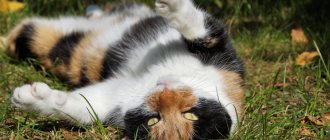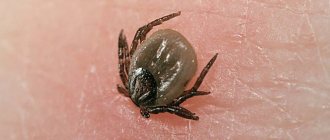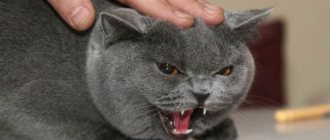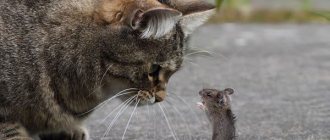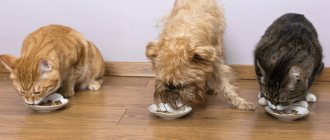Sometimes our pets get sick.
And then it becomes uneasy, because the owner does not know what’s wrong with the pet, and, most importantly, how to help him? Not all symptoms are specific and “tell” why exactly the purr is unwell.
But based on general symptoms (diarrhea, vomiting or constipation), you will not be able to independently determine the cause of your pet’s illness.
So why does the cat vomit? Natural cleansing of the stomach from licked fur or a symptom of a disease?
What should you do if your cat is constantly vomiting, mixed with blood or bile? More details about everything.
Causes of vomiting
- Irritation of the stomach/throat mucosa by something hard (a hairball in the stomach or a fish bone stuck in the throat). Often cats accidentally swallow something small and inedible, starting to chew out of interest. Then in the vomit you can see what led to intestinal antiperistalsis.
- Overfeeding your pet. If the owners try to put more in the purr’s bowl, thinking that this is better, that their four-legged friend will be full longer, then the fluffy overeats. And then there is no doubt why exactly the cat started vomiting. Vomit is undigested pieces of food, and the cat vomits only after overfeeding; if the portion is reduced, then such attacks will not occur again.
- Vomiting in a cat can also occur due to poor quality food. The pet will probably be poisoned. Then the toxins act on the brain receptors (more precisely, on the vomiting center), hence the reverse peristalsis.
- Do not forget that a purr can be poisoned not only by food, but also by chemicals, medications (especially if the owner is self-medicating), and indoor plants. There are a great many poisons and toxins, they affect the vomiting center in the brain.
- Why else might a cat start vomiting? Due to severe helminthic infestation. In the process of living inside the host, intestinal helminths release toxins, which again poison the cat.
- Inflammatory processes in the gastrointestinal tract. They are not always of non-contagious etiology. Much more often these inflammations are a consequence of infectious diseases. And if you do not contact a veterinarian for help as soon as possible, the pet will die.
- However, diseases of the digestive system that lead to vomiting may not be of an inflammatory nature. For example, intestinal obstruction, torsion of its loop. Without timely surgical intervention, it will not be possible to save the cat. No amount of herbs or pills will help here, which is why it is so important to go to the veterinarian when your cat vomits.
- Brain damage. These are injuries (concussion or bruise), swelling, increased intracranial pressure - all this can cause a cat to vomit.
What symptoms require you to contact a veterinarian?
The kitten should be shown to a veterinarian as soon as possible in the following cases:
- vomiting is profuse, repeated more than 3 times in a short period of time;
- there is blood, bile or foam in the vomit;
- the urge to vomit is painful;
- nausea is accompanied by other symptoms - convulsions, loss of consciousness, high body temperature.
If you suspect poisoning by poisons, chemicals or drugs, you cannot hesitate - every minute of inaction by the owner can cost the pet’s life. Based on the examination and collected medical history, as well as the results of laboratory and instrumental studies, the doctor makes a diagnosis and prescribes treatment. Depending on the situation, the patient may be prescribed antiemetic, antiviral, antibacterial and painkillers.
If vomiting is caused by poisoning, the animal is given a gastric lavage and medications are prescribed that block the action of toxins. In some cases (for example, if a foreign body enters the esophagus), the animal may require surgical intervention.
Diagnostics
If reverse intestinal peristalsis occurred once and did not recur, and the cat herself feels great and behaves normally, then there are probably no serious illnesses.
Often you don't need to do anything. Perhaps the reasons were overfeeding or a hairball.
If vomiting recurs (at least three times during the day), then entrust the diagnosis to a veterinarian; it is not necessary to go to the clinic, you can call him at home (many clinics provide this service).
You will be required to tell the veterinarian as much as possible about the purring.
The first thing you need to remember is what the pet was fed or given (medicines, treats, or maybe the cat reached for a flower or a bottle of household chemicals), mention vaccinations, dewormings (latest dates), remember if there were any injuries.
You need to take a closer look at the vomit. What do they mainly consist of? If from undigested food residues, then problems may be associated with overfeeding, intestinal blockage, a foreign body in the stomach, and the quality of the food (for example, food that is too fatty or of poor quality).
If a cat's vomiting is accompanied by fever, diarrhea, or any other symptoms, then most likely the cause is an infection.
And without specific treatment (immunoglobulins or antibiotics), alas, there is practically no chance of a quick and complete recovery.
It is necessary to tell the veterinarian about the color of the vomit (white, yellow, with blood, with foam, etc.). This will help to more accurately determine the possible cause of your beloved cat’s illness.
And only after diagnosis can you begin to treat your pet.
What will happen to the mole next?
After trauma, as in any other place, the mole will hurt a little and turn slightly red - this is normal. Gradually, after 2-3 weeks, these phenomena should go away on their own. The only situation in which medical intervention may be required is the suppuration of a mole after a severe injury. This means that if after a few days a viscous white (not yellow) liquid begins to come out from the site of injury, you need to be examined by a surgeon. After 1-2 days, a crust will appear at the site of the injury, which will fall off on its own after 1-2 weeks.
Cat treatment
What should an owner do when his four-legged family member vomits? The first step is to call a veterinarian or go to the clinic with the animal yourself.
The veterinarian will examine the patient, provide first aid: if necessary, rinse the stomach and put in an IV. If necessary, prescribe a course of antibiotics.
There is no need to self-administer antiemetic drugs. Firstly, vomiting is a protective reaction of the body, perhaps in this way it tries to cleanse the gastrointestinal tract of toxins.
And by prescribing antiemetic drugs yourself, you will ensure that toxins and poisons penetrate into the blood, thereby only worsening the animal’s well-being.
Secondly, self-medication is always a risk. You can make a mistake with the dosage. And thirdly, such actions by the owners significantly complicate the veterinarian’s work. It is much more difficult to make a diagnosis when many symptoms disappear before examination.
Only the veterinarian makes the decision: what and in what dosage can be given to a cat with vomiting. All you can do is not feed your cat more, but provide him with access to clean water. Dehydration is very dangerous.
Your veterinarian will probably advise you to give your pet a teaspoon (teaspoon) of a special saline solution every 10-15 minutes at home.
There is no need to pour in the entire glass, this will only provoke a new attack of vomiting. It is better to keep such powders (they are then dissolved in chilled boiled water according to the instructions) in your first aid kit, and they are sold in any “human” pharmacy.
If the cause of vomiting is a volvulus or intestinal obstruction, then surgery will be required. But again, you can only find out about this after you show your pet to the veterinarian.
If you decide to do without qualified help and do everything yourself (give enemas, inject antibiotics, give antiemetics), then you risk losing your pet.
Contact your veterinarian as soon as you notice that your pet is unwell.
Types of vomiting in cats
First, let's talk about physiological vomiting, which is not dangerous to your pet's health. It could be:
- Vomiting from eating grass - cats use it to cleanse the body. If a cat ate green grass and vomited green grass, then this is normal and even healthy. However, sometimes cats quite successfully digest all the grass, and if they eat it, this does not mean that vomiting will soon begin.
Cats love green grass, with which they cleanse their bodies and replenish their supply of vitamins.
- Vomiting from psychological trauma - Some cats may react by vomiting to moving, rearranging furniture, or introducing a new pet into the house. Knowing this characteristic of a cat, it is better not to feed the animal on this day or reduce the amount of food - this will help prevent an unpleasant reaction from the cat’s body.
- Vomiting from motion sickness during long trips is quite common in cats. To prevent such vomiting, you can use mild herbal-based sedatives, and do not feed your pet for 7-8 hours before the trip.
- Vomiting from eating inedible objects - some cats tend to swallow threads, pieces of plastic, candy wrappers, hair ties and even small toys. As a rule, in such animals vomiting occurs easily and frees the body from inedible objects. However, if difficulties or symptoms of difficulty breathing occur in a cat with such vomiting, you should immediately consult a doctor.
- Vomiting from swallowing fur - sometimes cats get nervous and lick their fur especially actively, after which they may even develop bald spots on their stomachs. To facilitate the removal of fur from the body, there are special vitamins and treats, and you can also help the cat by introducing a teaspoon of petroleum jelly into the mouth.
Similar products can be used for cats of any kind, especially long-haired breeds, which often tear their hair.
Non-dangerous vomit is most often transparent, with visible and understandable contents: wool, grass, threads, pieces of food.
Vomiting after eating undigested food or dry food
This is a typical type of vomiting seen in domestic cats. The rapid pace of food absorption, large volumes and poor chewing lead to the fact that the stomach does not have time to stretch and throws the contents back. The cat may vomit immediately near the bowl or a few minutes or even half an hour after eating. The animal can then return to the bowl and ask for food again. There is only one way out - limit food portions. Dry food must be chewed so that you can hear how its pieces crunch. If the animal swallows them whole, then the likelihood of vomiting increases greatly. In addition, when washed down with water, the food actively swells in the stomach, so initially the cat needs to eat much less.
Eating greedily and quickly is the most common cause of vomiting in cats.
The author of the article has a beloved old cat of the Thai breed, which is already 17 years old. In the last 3-4 years she has been vomiting quite often, and we are very familiar with this problem. About 1-2 times a week she regurgitates dry food, which she previously swallowed without chewing. She has special, premium food, designed for good digestion, the pieces are not very hard, they are easy to chew. But the cat already has very bad teeth, so from time to time, when she is too lazy or has no time to grind the pieces, she eats them quietly, quickly and without any crunching. This process is also influenced by the presence of a second animal in our house, a young and healthy cat, who eats completely different food from his bowl nearby (for young castrated males), but looks towards the cat in order to move it away from the feeder and eat everything that lies there. Usually we follow this process and do not allow the cat to eat someone else’s food, but sometimes we get distracted and see the final scene: the cat walking away from its bowl and the cat finishing the food behind it. Therefore, the cat periodically eats greedily, quickly, without chewing, after which after 10–15 minutes, maximum half an hour, it begins to slurp and lick its lips, then runs to the floor, coughs there, and it is on the carpet (favorite place) that the entire contents of breakfast or dinner are thrown out. It looks like slightly overcooked (rarely) or not chewed food at all (usually). The cat feels guilty and immediately hides. Sometimes she doesn’t have time to reach the floor and vomits right on the bed where she sleeps. I have to clean up piles of food after her and wash her beds. It's not scary, but it's unpleasant. This happens about once a week. If you feed your cat wet food of the same line, there will be no vomiting, because it is soft and well crushed. Usually after a bout of vomiting I feed her a little less than usual. But we must give the cat his due; after burping, she never returns to the bowl and asks for more food. She arranges a diet for herself for 3-4 hours, and only then intensively asks to eat. Sometimes after an attack of vomiting he goes to a bowl of water and drinks a lot. The funny thing is that the cat, when he was young, tried to eat the food that she regurgitated. Now he has wised up and doesn’t do that anymore. Sometimes a cat also vomits hair, but this happens very rarely, about once every 2-3 months, during periods of active shedding. A young cat also vomits, but very rarely and never with food. He has two problems - vomiting grass when he eats too much, and vomiting foam with fur during active shedding. But since a cat licks itself much less than a cat, it also vomits its fur literally a couple of times a year and little by little. And the pet regurgitates the grass in the warm season, when we walk with him on a harness, and he absorbs the grass in the quantities his body needs. It can be concluded that young cats have far fewer problems with vomiting than older cats. And it is better to switch old cats to wet food, this will serve as a preventive measure against vomiting.
Vomiting yellow liquid (bile)
Vomiting bile means that the animal has not eaten for more than 24 hours or the contents of the stomach have previously been completely released into the environment. Bile is released from the small intestine, liver, and duodenum. This is usually a sign that the cat is hungry and not feeling well, often accompanied by lethargy and lack of appetite. In this case, it is better to show the animal to a veterinarian.
If, in addition to vomiting, the animal has a lack of appetite and a lethargic state, then you need to take it to the veterinarian for examination as quickly as possible.
If the bile is dark yellow in color, it may be hepatic vomiting associated with a foreign body inside the body or parasites.
Persistent, repeated vomiting of bile in a pet may indicate chronic diseases of the gallbladder, liver or intestines. Fatty or stale food, overeating and swallowing large pieces of food can provoke an exacerbation.
Vomiting white foam
The appearance of white foam means hungry vomiting, which is formed due to the secretion of juice in an empty stomach. To protect the mucous membrane from an aggressive environment, a special protein is produced in the stomach, which comes out in the form of white foam.
This occurs due to long-term fasting, the presence of parasites, gastritis, chemical poisoning, etc. Vomiting with white foam, occurring 1-2 times while maintaining appetite, is not considered dangerous, but if there was more urge to vomit, it is reduced or There is no appetite, and the animal’s condition is causing concern, then a doctor’s consultation is required.
Kitten vomiting
Vomiting in kittens is very dangerous and the younger the baby is, the less chance of saving him even with qualified medical care. Dehydration has a detrimental effect on kittens and can quickly lead to death. Most often, vomiting at an early age indicates congenital disorders of the digestive system or low-quality mother's milk. Difficulties in treating cubs are associated with the unpredictable effects of drugs on the young body.
Kittens from 3 months of age are considered as adult animals and the same treatment methods are applied to them.
Other types of vomiting
Vomiting blood is considered the most dangerous and always requires medical intervention. Most often, it indicates a viral infection or an exacerbation of a peptic ulcer. Also, persistent, prolonged vomiting can cause small vessels in the digestive tract to burst. Brown blood is undigested blood, which means liver dysfunction or other dangerous diseases, so the owner of the animal will need to take urgent measures in order not to lose the pet - it must be taken to a veterinary clinic as quickly as possible.
Green vomit means problems with the pancreas, blockage of the gastrointestinal tract, which is often observed with infectious and viral diseases.
Video: Vomiting in cats - veterinarian advice
When emergency help is needed
There are cases when consultation with a veterinarian is urgently required. For example, if an animal has frequent vomiting, and it does not stop even after the stomach is empty, the mass itself is copious.
Diarrhea and vomiting in a cat: what to do at home
The discharge contains impurities unusual for normal vomiting, including bloody inclusions. Also, for a long time, the kitten is lethargic, constantly sleeps, does not play, does not eat, and shows little interest in the world around it. Vomiting is accompanied by fever and high temperature. The pet may diarrhea. If the animal’s general condition rapidly deteriorates, you should visit a doctor immediately.
Reference! Due to their age, kittens are quite playful and curious. Therefore, it is easy to notice from them that they have become lethargic and less active. This is one of the main and first symptoms that should alert the owner.
Dietary food for vomiting: the kitten has eaten too much, what to do?
Vomiting occurs when the kitten has eaten too much. Then it is necessary to establish its nutrition. Undigested food often causes cramps. For the first 10 hours the animal remains without food. This is a beneficial fast that allows you to calm down an irritated gastrointestinal tract. Water is not excluded from the diet at all. It is necessary to water the kitten. If he doesn't drink himself, the owner takes matters into his own hands. After some time, you can introduce milk.
Diet for vomiting
Avoid heavy, salty and spicy foods. If the main food is dry food, then for the duration of the diet it is better to purchase special medicinal types. You can add boiled chicken, boiled rice or baby food to your diet.


